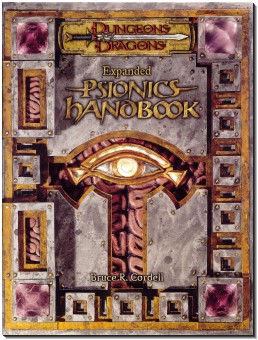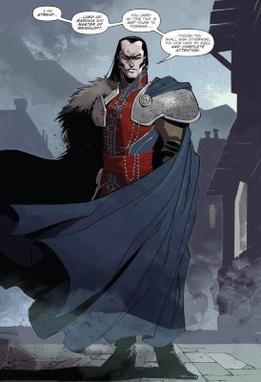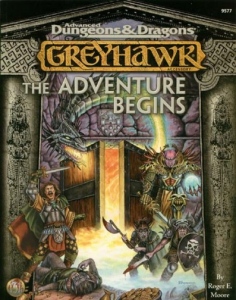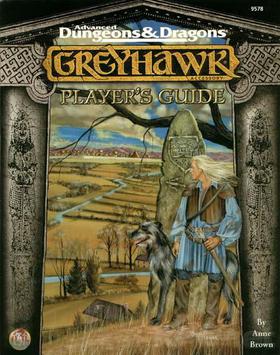 | |
| Genre | Role-playing games |
|---|---|
| Publisher | TSR |
Publication date | 1998 |
Champions of the Mists is an accessory for the 2nd edition of the Advanced Dungeons & Dragons fantasy role-playing game, published in 1998.
 | |
| Genre | Role-playing games |
|---|---|
| Publisher | TSR |
Publication date | 1998 |
Champions of the Mists is an accessory for the 2nd edition of the Advanced Dungeons & Dragons fantasy role-playing game, published in 1998.
Champions of the Mists is a sourcebook which provides information on how the character classes interact with the Ravenloft setting, and the book provides new character class kits, and a number of non-player characters from books in TSR's fiction line, as well as past published adventures and editions of Ravenloft. [1] The book begins by briefly introduction the various classes of Champions of the Mists, covering the four core classes of warrior, wizard, cleric, and thief, but not the new classes from Domains of Dread or optional classes from the Player's Handbook . [1] The next section, "The Crucible", lists new character class kits for Ravenloft. [1]
Champions of the Mists was written by William W. Connors. [1] It was published in June 1998. [2]
Champions of the Mists was reviewed by the online version of Pyramid on July 23, 1998. [1] The reviewer observed that for many years, "Ravenloft has been a setting that characters came to from another campaign and adventured in only briefly", but that with the release of the hardcover Domains of Dread , "TSR made it a place where characters can start off in the demi-realm with their own classes and secret societies" and felt that Champions of the Mists furthers that effort. [1] The reviewer felt that the book omitting the new classes from Domanins of Dread and the optional classes from the Player's Handbook was not a great difficulty "if one uses the ideas here and applies them in a slightly different manner to the class in question. Most of the notes for a warrior can apply to a paladin or even a ranger with little tinkering." [1]

Ravenloft is a campaign setting for the Dungeons & Dragons roleplaying game. It is an alternate time-space existence known as a pocket dimension or demiplane, called the Demiplane of Dread, which consists of a collection of land pieces called "domains", brought together by a mysterious force known only as the Dark Powers. Each domain is tailored to and mystically ruled by a being called a Darklord who is forever trapped and surrounded by magical mists surrounding the domain. Strahd von Zarovich, a vampire in the original AD&DRavenloft I6 module released in 1983, became the first Darklord, both ruler and prisoner of his own personal domain of Barovia. The story of how Count von Zarovich became Darklord of Barovia was detailed in the 1993 novel I, Strahd: The Memoirs of a Vampire. As originally established in the Ravenloft: Realm of Terror boxed set known as "the Black Box" released in 1990, the Ravenloft campaign setting was located in the Ethereal Plane. As a physical manifestation of that plane, lands, monsters and even people were created out of the mysterious mists, and the realm acted as a prison where one could enter or be transported, but means of escape were few. Other Ravenloft Domains and Darklords were eventually added in various AD&D 2nd edition products establishing a core continent attached around Barovia which could be traveled to by others if their respective lords allowed entering or leaving their borders; while some Domains remained isolated in the mists and were referred to as Islands.

Planescape is a campaign setting for the Dungeons & Dragons fantasy role-playing game, designed by Zeb Cook, and published by TSR in 1994.

In the Dungeons & Dragons fantasy role-playing game, illithids are monstrous humanoid aberrations with psionic powers. In a typical Dungeons & Dragons campaign setting, they live in the moist caverns and cities of the enormous Underdark.
In the Dungeons & Dragons fantasy role-playing game, psionics are a form of supernatural power similar to, but distinct from, arcane and divine magic. Psionics are manifested purely by mental discipline. Psionics were introduced in the original supplement Eldritch Wizardry. Psionics have appeared as part of the core rules beginning with Advanced Dungeons & Dragons 1st edition.

The Expanded Psionics Handbook is a sourcebook written by Bruce Cordell for the 3.5 edition of the Dungeons & Dragons fantasy roleplaying game that contains rules and options for integrating psychic powers into the game. Along with its predecessor, the Psionics Handbook, the Expanded Psionics Handbook expands and adapts the psionics concept with a new emphasis on balance and playability.

Ravenloft is an adventure module for the Dungeons & Dragons (D&D) fantasy role-playing game. The American game publishing company TSR, Inc. released it as a standalone adventure booklet in 1983 for use with the first edition Advanced Dungeons & Dragons game. It was written by Tracy and Laura Hickman, and includes art by Clyde Caldwell with maps by David Sutherland III. The plot of Ravenloft focuses on the villain Strahd von Zarovich, a vampire who pines for his lost love. Various story elements, including Strahd's motivation and the locations of magical weapons, are randomly determined by drawing cards. The player characters attempt to defeat Strahd and, if successful, the adventure ends.

Count Strahd von Zarovich is a fictional character originally appearing as the feature villain in the highly popular Advanced Dungeons and Dragons adventure module I6: Ravenloft. Later, this character and his world would be explored in follow-up modules, novels, and the Ravenloft campaign setting. Within this setting, Strahd is the first and best-known of Ravenloft's darklords. He is a powerful ancient vampire. He is also a master necromancer, a skilled warrior, and the unquestioned ruler of the domain of Barovia.

Oriental Adventures is the title shared by two hardback rulebooks published for different versions of the Dungeons & Dragons (D&D) fantasy roleplaying game. Each version of Oriental Adventures provides rules for adapting its respective version of D&D for use in campaign settings based on the Far East, rather than the medieval European setting assumed by most D&D books. Both versions of Oriental Adventures include example campaign settings.

The Forgotten Realms Campaign Setting is a role-playing game sourcebook first published by TSR in 1987 for the first edition of the fantasy role-playing game Advanced Dungeons & Dragons that describes the campaign setting of the Forgotten Realms. It contains information on characters, locations and history. Various revised and updated editions have been produced over the years.
Al-Qadim is a campaign setting for the Dungeons & Dragons role-playing game which was developed by Jeff Grubb with Andria Hayday for TSR, Inc., and was first released in 1992. Al-Qadim uses One Thousand and One Nights as a theme and is set in the land of Zakhara, called the Land of Fate. Thematically, the land of Zakhara is a blend of the historical Muslim Caliphates, the stories of legend, and a wealth of Hollywood cinematic history. Zakhara is a peninsula on the continent of Faerûn in the world of Toril, the locale of the Forgotten Realms campaign setting, although Al-Qadim is designed to stand on its own or be added to any existing campaign setting. The basic campaign setting was divided between two game products: Al-Qadim: Arabian Adventures, a sourcebook describing character creation rules, equipment, and spells unique to the setting, and Al-Qadim: Land of Fate, a boxed set describing the land of Zakhara, with separate sourcebooks for the players and the Dungeon Master.
The flexibility of the Dungeons & Dragons (D&D) game rules means that Dungeon Masters (DM) are free to create their own fantasy campaign settings. For those who wanted a pre-packaged setting in which to play, TSR, Wizards of the Coast (WotC), and other publishers have created many settings in which D&D games can be based; of these, the Forgotten Realms, an epic fantasy world, has been one of the most successful and critically acclaimed settings. Many campaign settings include standard sword and sorcery environments, while others borrow Asian, Central American, swashbuckling, horror and even space-travel themes.

In the Dungeons & Dragons fantasy role-playing game, goblins are a common and fairly weak race of evil humanoid monsters. Goblins are non-human monsters that low-level player characters often face in combat.
In the Dungeons & Dragons fantasy role-playing game, a vampire is an undead creature. A humanoid or monstrous humanoid creature can become a vampire, and looks as it did in life, with pale skin, haunting red eyes, and a feral cast to its features. A new vampire is created when another vampire drains the life out of a living creature. Its depiction is related to those in the 1930s and 1940s Hollywood Dracula and monster movies. In writing vampires into the game, as with other creatures arising in folklore, the authors had to consider what elements arising in more recent popular culture should be incorporated into their description and characteristics.

Song and Silence: A Guidebook to Rogues and Bards is an optional rulebook for the 3rd edition of Dungeons & Dragons, and notable for its trade paperback format.

Sword and Fist: A Guidebook to Fighters and Monks is an optional rulebook for the 3rd edition of Dungeons & Dragons, written by Jason Carl and published in trade paperback format.

Greyhawk: The Adventure Begins is a 1998 sourcebook for the World of Greyhawk campaign setting for the Dungeons & Dragons roleplaying game. The 128 page book was written by Roger E. Moore and published by Wizards of the Coast under the TSR imprint it had recently acquired.

The Player's Guide, also known as the Greyhawk Player's Guide or the Player's Guide to Greyhawk, is a sourcebook for the World of Greyhawk campaign setting for the Dungeons & Dragons role-playing game. Written by Anne Brown, the work was published by Wizards of the Coast under its TSR imprint in 1998.

Masque of the Red Death and Other Tales, subtitled "Terror in the 1890s", was published by TSR in 1994 as an alternate campaign setting for the horror fantasy role-playing game Ravenloft, which itself uses the rules from the 2nd edition of Advanced Dungeons & Dragons.

The Dungeons & Dragons Adventure Game is the name of two companion accessories to the second and third editions of the Dungeons & Dragons fantasy role-playing game. Designed as simpler, stand-alone versions of Dungeons & Dragons, they feature a simplified ruleset, but with character progression that parallels the standard game. However, for 3rd-level characters and higher, the standard Player's Handbook is still required. The first version was published in 1999 for the second edition of Advanced Dungeons & Dragons, while the second version was published in 2000 for the third edition of Dungeons & Dragons.
William W. Connors is a game designer who has worked primarily on role-playing games.